ISSN ONLINE(2319-8753)PRINT(2347-6710)
ISSN ONLINE(2319-8753)PRINT(2347-6710)
J. Jayakumar1,3,B.K.Raghunath2,T.H.Rao3
|
| Related article at Pubmed, Scholar Google |
Visit for more related articles at International Journal of Innovative Research in Science, Engineering and Technology
Mechanical properties of Metal-Matrix Composites (MMCs) can be enhanced significantly by the reinforcement of MWCNTs(Multi Wall Carbon Nano Tubes) into AZ31 Mg alloy. Efforts are underway to improve fracture resistance of the materials through understanding of the deformation and failure mechanisms. In this research a systematic examination of the effects of weight fraction of MWCNTs on the mechanical properties and fracture mechanism of AZ31-MWCNT nano composites has been undertaken. The material used in this investigation was a powder metallurgy processed AZ31Mg alloy reinforced with 0.33wt%,0.66wt% and 1wt% fraction of MWCNTs. The samples were tested at room temperature for uniaxial compression and sample sections were characterized for microstructure properties using optical microscope and SEM (Scanning Electron Microscope).The effect of addition of weight fraction of MWCNTs on mechanical property,microstructure and fracture modes are studied. The result reveals that the fracture modes of the composites were increased by the increased weight fraction of MWCNTs because of their agglomeration and the clusters and microvoids are susceptible route for crack propagation
Keywords |
| AZ31-MWCNT Composites, Multi Wall Carbon Nano Tubes, Mechanical alloying, High Energy Ball Milling, Powder Metallurgy process, Damage mechanism. |
INTRODUCTION |
| Metal Matrix Composites (MMCs) are widely known to have relatively superior mechanical properties, better wear resistance, high elastic modulus and yield strength compared to monolithic metals. Particulate reinforced MMCs are considered as a better one than the fiber reinforced because of its ease of fabrication and lower fabrication cost [1,2]. Magnesium based MMCs among other MMCs are widely used in various applications in aerospace, automobiles, sports equipments because of its low density and better mechanical properties[3]. CNTs (Carbon nano tubes) are the most exciting nano structured materials of the 20th century with superior mechanical, thermal and electrical properties discovered by Iijima [4].CNTs are discovered to have young’s modulus and tensile strength of 3TPa and 2GPa respectively and density to have 2.0g/cm3[5-6].Looking in to these properties CNTs could be an ideal reinforcement for Magnesium and its alloy as matrix material. Fracture in particulate-reinforced composites is strongly dependent on the particulate strength and particulate- matrix interface strength. Fracture can occur in the form of: particulate fracture, near particulate fracture, debonding between matrix and reinforcement, near interface failure and fracture between particulate agglomerations. Particulate fracture or a weak interface is unlikely in nano-metric scale particulate-reinforced composites. This is due to the fact that the nanoparticles are less likely to contain defects or to be damaged during the materials synthesis process. However, they are more prone to particulate clustering which could severely degrade the strength and ductility of the matrix by initiating localized damage[7]. Several researchers observed the particulate clustering phenomenon in their investigation on nanometric-particulate reinforced composites [8-10]. However, the results of literature search indicate that no attempt has been made to improve the overall compressive behavior of Mg alloy AZ31 by reinforcing the MWCNTs through powder metallurgy process and mechanical alloying.In this research work, the effects of varying content of MWCNTs on the mechanical properties and damage behavior of AZ31-MWCNT nano composites are investigated and compared with the monolithic AZ31Mg alloy. |
EXPERIMENTAL DETAILS |
| Magnesium(Mg) powder with 99.5% purity supplied by Neeraj Industries, Rohtak, Haryana, India was used as the matrix material. The Multi Wall Carbon Nano Tubes(MWCNTs) produced by Nano Shell(USA),supplied by Intelligent materials Pvt Ltd,Chandigarh was used as reinforcement material. The specification of the reinforcement material is given in Table.1.Powder metallurgy process was used to synthesize both AZ31 alloy and AZ31-MWCNT nanocomposites.The reinforcement material MWCNT with three variations of 0.33wt%, 0.66wt%, 1wt% were added to the matrix of AZ31 alloy and blended using a high energy ball mill for 2h at a speed of 300RPM.Tungston carbide balls were used with ball to powder weight ratio of 1:15.The blended powders are checked for homogeneous distribution using microstructures of the SEM analysis. Mechanical alloying using high energy ball milling has helped the CNTs to reinforce homogeneously in to the AZ31 matrix. The homogeneously blended powders in different variations of CNTs were compacted into cylindrical billets of 30mm diameter. The compacted specimens of AZ31 and AZ31-MWCNT were sintered at 630oC for 2h in a tubular sintering furnace under inert atmosphere. Monolithic AZ31 alloy billets without CNTs were also fabricated by the same process. Density was measured by Archimedian’s principle and the hardness was measured using Vickers hardness tester with a load setting of 5KN and dual time of 15sec at 5places on each sample and the average was taken. |
 |
| Compression test was conducted for investigation of crack behavior in samples according to standard ASTM E9 at room temperature with L/D: 1.5 and strain rate of 5x10-4 s-1. The tests were continued till two points: 1- ultimate reduction of stress which was assumed as fracture point and 2- the point in which 8% strain was occurred. For observation of crack behavior during the compression test samples were sectioned longitudinally by a low speed diamond saw. Optical and scanning electron microscopes (SEM) were used to examine fracture route after compression test. Since specimen preparation process itself may produce damages such as scratches, cracks and voids and the defects have a significant influence on the measured damage, image analysis (MIP) was carried out on samples before and after compression test and found that it is not possible to prevent such occurrences entirely. Therefore, to account for this problem, damage levels produced in deformed specimens were compared with those in undeformed specimen prepared exactly by the same way. |
RESULTS AND DISCUSSION |
| A. Effect of MWCNT content on density |
| The effect of MWCNT content on the density and porosity of sintered samples are shown in Fig.1. The result shows small decrease in density with 0.33wt% and 0.66wt%CNT samples and larger decrease in density with 1.0wt%CNT sample compared to the monolithic Mg alloy. The porosity results shows small increase with 0.33wt% and 0.66wt% samples and increases largely with 1wt%CNT samples. The reason behind the increase in porosity is due to the clustering effect of CNTs. When more volume of CNTs added in to the Mg alloy matrix, the work of force decreases and leads to a possible reason for the increase in clustering effect which will inevitably lead to increase in porosity and decrease in the density. |
 |
| B.The effect of CNT content on the stress-strain behavior |
| Since powder metallurgy processed parts are porous, they have superior compressive properties in comparison with the tensile properties. Fig.2 shows the effect of MWCNT weight percent on the stress-strain behavior. The observed variation is the result of the change in mechanical properties with the addition of weight percent of MWCNTs. As the diagram indicates the sample containing 0.66 wt.% alumina has generally better properties than the others. On the other hand, as the reinforcement phase increases, the final strain decreases. The ultimate compression strength increases with the addition of the reinforcement MWCNTs upto 0.66wt% in Mg alloy. The ultimate strength increases because of the presence of high strength MWCNTs and prevent the movement of dislocations in Mg alloy matrix through the dispersion strengthening mechanism [12,13]. However, further increase in the amount of MWCNTs raises the possibility of clustering and finally initiates the formation of weak regions in the composites. Therefore, this phenomenon prevents the strength increasing in the samples which contain 1wt.% MWCNTs. |
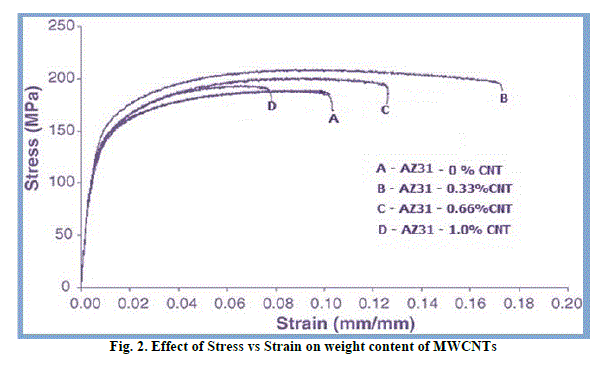 |
| C. Damage behavior |
| Because of the heterogeneous distribution of reinforcement particles and the related inhomogeneous distribution of stress in PMMCs, it is apparent that there should be a strong relationship between local microstructure and damage formation. The damage tends to originate preferentially in clustered regions of high volume fraction[14]. The damage contents were determined in the samples, before and after compression test, using image analyzing process described earlier. The relation of defect content with nanoparticle weight percent of the composites is shown in Fig. 3. As the figure shows, there is high amount of defects (voids and cracks) in samples before compression test which increases with MWCNT content. |
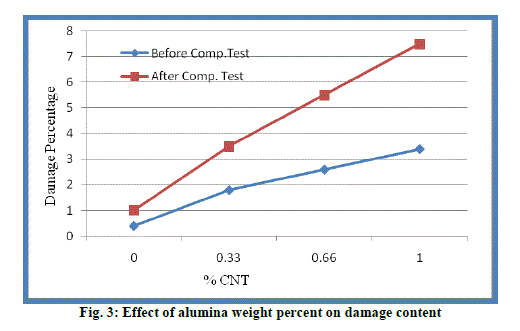 |
| As mentioned before, the value of damage (voids and cracks) was measured using image analysis (MIP) on samples before and after compression test. For samples after compression test, an abruptly increase in damage content with increasing MWCNT is observed. The increase is more noticeable in these samples in comparison with the samples before compression test. This evidence shows that clustering has important effect on initiation and development of damage during applying stress. |
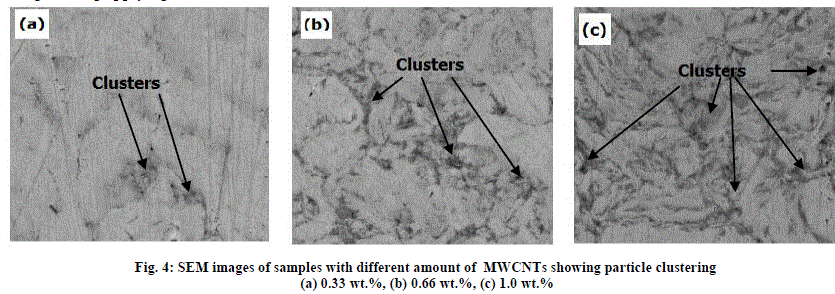 |
| Fig.4 shows that clustering increases with MWCNT content. The reason is that the nano-scaled reinforcements have a large surface-to-volume ratio, causing the chemical reactions and diffusion to occur easily, moreover, the agglomeration prevents composites from densification [15]. This clustered structure has a significant effect on damage formation in the composites.Fig.5 shows the optical microscopy images of samples containing 0.33,0.66,1.0wt.% MWCNT after compression test. In AZ31 sample, crack follows the normal behavior of ductile metals and dimples form with the formation of defects and their development. With the addition of MWCNTs, clustering first occurs in AZ31 particle boundaries. In addition, with increasing MWCNT, clustered layers become coarser and closer to each other and create a MMC network among the AZ31 particles. Therefore, the MWCNT percent in MMC networks is more than the average content of MWCNT in the whole sample. Mg alloy regions with low amount of MWCNTs produce tough structures [17]. This type of microstructure provides crack branching and crack deflection in the composites. When cracks intersect to the tough regions they tend to choose the easier route therefore, they change their routes and consume more energy than in the samples containing high amount of MWCNTs. |
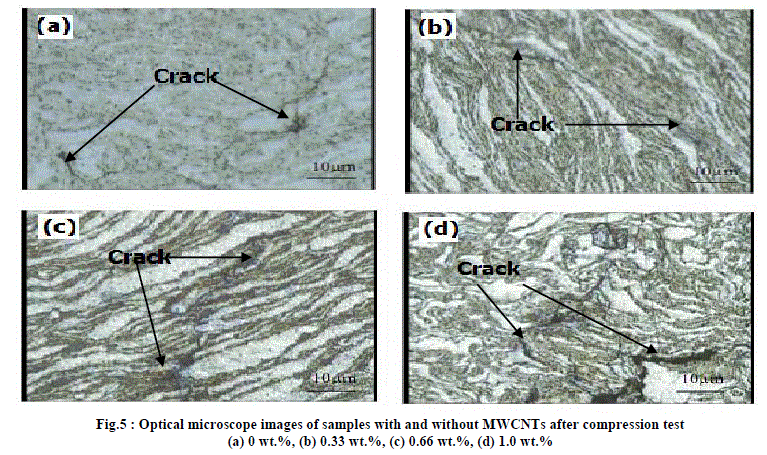 |
| In conclusion, with increasing MWCNT content, the crack route becomes straighter and consequently less crack networks are formed. Cracks propagate through the voids initiated among the clustered regions. Prangnell et al.[9] have been reported that before clustering, plastic flow on planes at 45º links up perfectly across opposing particle corners, causing the plastic strain to be highly concentrated in 45º bands at particle corners. Moreover, tensile stresses form in the corners and perpendicular to compression axis. With clustering, plastic flow on planes at 45º can no longer connect across particle corners and becomes concentrated by the sides of neighboring particles. Plastic strain now, becomes most concentrated at the corner of the clusters instead of at each individual particle. Therefore, it would be expected that plastic strain links up across the corners of clusters in materials containing high local volume fractions of cluster.At the same time, maximum stress on the particles at the center of clusters dramatically reduces with more clustering. Tensile hydrostatic stress generates in the clusters deformed in compression due to the restraining effect of the cluster on the plastic flow. Three-dimensional tensile constraints are the reason of void formation in the clustered regions [9,17]. |
| D. Effect of strain on damage content |
| Table 2 shows the damage content of different samples before compression test, after 8% strain and in the ultimate strain. As expected, damage content increases with increasing MWCNTs and the strain. Fig.6 is the SEM images of sample containing 1.0wt.% MWCNT in different strain conditions. |
 |
| It can be observed from image of 8% strain that microvoids are concentrated in the regions with clustered and high quantity of MWCNTs. With increasing strain, cracks use the microvoids for propagation. The increase has a higher rate in the case of samples with more alumina content, because of increasing the clustering.It can be observed that there are a lot of microvoids and elongated Mg alloy regions with low amount of MWCNT among the microvoids on fracture surface.The elongated regions were created during the production and compression test condition. It is observed that the microvoids contain MWCNT clusters. The same feature almost can be seen in all samples although, it is so serious in composites with higher MWCNTs. |
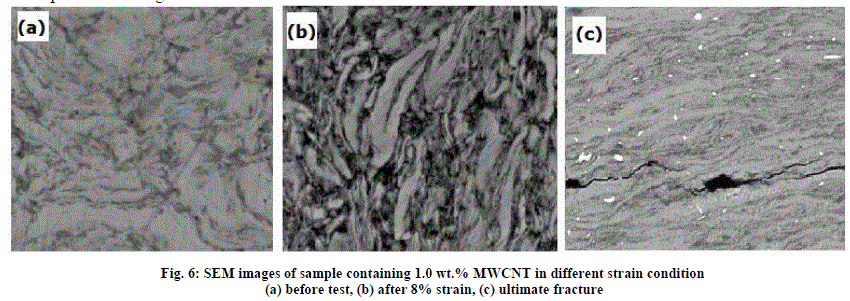 |
CONCLUSIONS |
| In this research the effects of addition of weight fraction of MWCNTs on the mechanical properties and fracture mechanism of AZ31-MWCNT nanocomposite has been studied. The following results were obtained: |
| 1. Ultimate compression strength improves with increasing MWCNTs up to 1.0wt.% into AZ31, however with more increasing the reinforcements, clustering causes to decline the compressive properties and overcome on strengthening mechanism. |
| 2. The damage rate of samples during the compression test increases with increasing the reinforcements, because clusters and microvoids are susceptible route for crack propagation. |
| 3. In samples with low reinforcement content (0.33 & 0.66wt.% MWCNT), crack branching and crack deflection are the damage mechanisms. |
| 4. In samples with higher reinforcement contents, damage develops with a lot of microvoid initiation and connection. |
ACKNOWLEDGEMENTS |
| We thank the in-charge and staff of the Manufacturing Lab, CEMAJOR Lab of Annamalai University, Chidambaram, Tamilnadu, India and Metallurgy and Material testing lab of PDVVP College of Engg., Ahmednagar, Maharashtra, India for extending co-operation in fabricating and studying the mechanical properties and fracture mechanism of the material. We thank Mr. Kiran Bhotkar of Icon equipments Pvt.Ltd, Mumbai, India for extending cooperation in analyzing the microstructures of the samples. |
References |
|